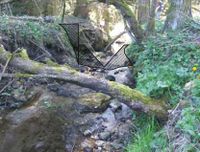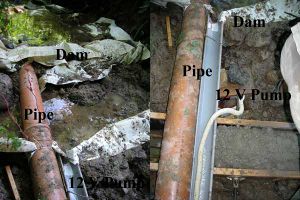Weir (Thomson Weir / V notch sharp crested weir)
Parameter to be measured:
Discharge of open channels
Method:
Equipment:
- Weir (concrete, wood, metal)
- V notch weir plate (stainless steel)
- Water Level Sensor:
- Bubble Sensor
- Shaft Encoder
- Radar Sensor
- Pressure Sensor
- (Capacity Sensor)
- Time
Construction:
- Planning: Before you can build a weir, you need permissions from different institutions. In my case (Bavaria, Germany) I needed permissions of following people:
- Owner
- Fishing rights
- District office
- Nature conversation agency
- Water right agency
It took quite a while (around three month) although the adminstration was helpful. I heard that it can take much longer. So start the administration stuff as soon as possible. Especially if the river falls under the nature conservaty right. possible.
- Accumulation and Drainage of the water: Before you can start the construction of the weir, you have to accumulate the water in front of the construction site and then you have to draine the water around or over the weir. If you have electricity you can use pumps (dirt water pumps). But be sure that the pumps can runover night, because the concrete has to dry at least twelve hours. Use at least two pumps, because it is a little tricky that all the water is pump away and that the pumps are not running dry. One big pump for most of the water and the other for the adjustment. In the case you don't have electricity, you can build one or two small temporary dams and then use a pipe to drain the river water over the weir. I think it is saver, because you don't have to relay on the pumps. I would suggest that you use a 12 V pump to get the water away which is leaking through the dam. You can run the pump with a battery.
- Digging: The Thickness of the walls and the depth of the bedplate depends on the expected discharge. I would suggest to dig at least 30 cm deep for the bedplate and in the bank walls 1 m.
- Casing and Placing the Concrete:You have to do the casing and the concreting in two steps: First you build the bedplate and then the walls of the weir. For the connection of both parts you can use some construction steel. For the ease of installation use casing boards and construction steel screws. With these you can easily define the thickness of the walls. First, build only the casing for the bedplate, because you have to compact the concrete. I used also some construction steel for reinforced concrete. If the casing and the steel construction for the bedplate is finished, you can start placing the concrete in the casing of the bedplate. The proper mixture for the concrete is 300 kg cement, 900 l water and 1800 kg aggregate. I used a mixture of 1 to 3, because I think the concrete sets faster, but about this I am not sure.
- Removal of Casing:
- Installation of the Water Level Sensor
- Installation of the Weir Plate
Advantages:
Disadvantages:
What to watch out for:
Problems/Questions:
Links
Projects that used the above equipment:
Other related web sites:

